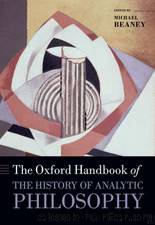The Oxford Handbook of The History of Analytic Philosophy by Michael Beaney

Author:Michael Beaney
Language: eng
Format: epub
Published: 2014-07-13T16:00:00+00:00
18.5 Last Writings
Having resigned his chair, Wittgenstein spent the rest of his life with various friends and disciples in Ireland, the USA, Oxford, and Cambridge. In some respects his work after the completion of Philosophical InvestigationsPart I marks a break. In that work mental concepts—intentionality, understanding, thinking—play an important role because of their connection with the main theme, the nature of language and meaning. Now philosophical psychology is discussed in its own right; indeed, between 1945 and 1949 it is the predominant theme of his writings and lectures. Whereas Philosophical Investigations is mainly concerned with attacking misconceptions, these works make steps towards a positive overview of mental concepts. But the emerging picture remains tentative.
Partly in reaction to Köhler’s Gestalt psychology, Wittgenstein sought to dissolve the paradoxical appearance of aspect-dawning. When looking at a picture like that of the duck-rabbit, we can come to see it differently, although we also see that the object itself remains unchanged; it seems to have changed and yet seems not to have changed. His solution is that aspect-perception lies between thinking and interpreting on the one hand, and immediate perception on the other. Wittgenstein also reflected on the philosophical significance of aspect-blindness, in particular on ‘meaning-blindness’, the inability to associate words with certain characteristic experiences. During his final years Wittgenstein also worked briefly on colours (ROC) and, more intensively, on epistemology in On Certainty. Though only a collection of notes, this last work is among his finest. As in the areas of mathematics and of other minds, Wittgenstein tries to show that sceptical doubts about our knowledge—in this case, our knowledge about the material world—and foundationalist attempts to meet these doubts are equally misguided. G. E. Moore had maintained that there are empirical truths which he can know with certainty, for example that he was a human being, that the object he was pointing to was his hand, or that the earth has existed for many years. According to Wittgenstein, these are not cases of sceptic-proof knowledge. Nevertheless, the propositions highlighted by Moore constitute the ‘scaffolding’ or ‘foundations’ of our language-games and of our ‘world-picture’. Sceptical doubt about them is futile, because our whole system of beliefs depends on them, including the beliefs which any doubt must take for granted. In recent years these ideas have inspired diverse attempts to undermine sceptical challenges (Stroll 1994; McManus 2004).
Although Wittgenstein’s main contributions lie in central areas of theoretical philosophy, the Nachlass and his lectures and conversations also feature intermittent reflections on aesthetics, ethics, religion, and other cultural issues (see Cottingham 2009; Oberdiek 2009; Glock 1996: 107–11, 320–3). Wittgenstein was a cultural conservative who felt at odds with the ‘spirit of the main current of European and American civilization’ (CV 6–7). He detested in particular its veneration for science and its faith in progress. The early Wittgenstein believed that aesthetics, ethics, and religion feature ineffable revelations. In his later writings he adopted a more plausible view, which continues to inspire current debate. The propositions of aesthetics, ethics, and religion are not nonsensical attempts to express the unsayable.
Download
This site does not store any files on its server. We only index and link to content provided by other sites. Please contact the content providers to delete copyright contents if any and email us, we'll remove relevant links or contents immediately.
| Algebra | Calculus |
| Combinatorics | Discrete Mathematics |
| Finite Mathematics | Fractals |
| Functional Analysis | Group Theory |
| Logic | Number Theory |
| Set Theory |
Modelling of Convective Heat and Mass Transfer in Rotating Flows by Igor V. Shevchuk(6391)
Weapons of Math Destruction by Cathy O'Neil(6139)
Factfulness: Ten Reasons We're Wrong About the World – and Why Things Are Better Than You Think by Hans Rosling(4691)
Descartes' Error by Antonio Damasio(3229)
A Mind For Numbers: How to Excel at Math and Science (Even If You Flunked Algebra) by Barbara Oakley(3217)
Factfulness_Ten Reasons We're Wrong About the World_and Why Things Are Better Than You Think by Hans Rosling(3197)
TCP IP by Todd Lammle(3131)
Fooled by Randomness: The Hidden Role of Chance in Life and in the Markets by Nassim Nicholas Taleb(3043)
Applied Predictive Modeling by Max Kuhn & Kjell Johnson(3018)
The Tyranny of Metrics by Jerry Z. Muller(3000)
The Book of Numbers by Peter Bentley(2907)
The Great Unknown by Marcus du Sautoy(2645)
Once Upon an Algorithm by Martin Erwig(2598)
Easy Algebra Step-by-Step by Sandra Luna McCune(2577)
Lady Luck by Kristen Ashley(2528)
Practical Guide To Principal Component Methods in R (Multivariate Analysis Book 2) by Alboukadel Kassambara(2497)
Police Exams Prep 2018-2019 by Kaplan Test Prep(2482)
All Things Reconsidered by Bill Thompson III(2354)
Linear Time-Invariant Systems, Behaviors and Modules by Ulrich Oberst & Martin Scheicher & Ingrid Scheicher(2331)
